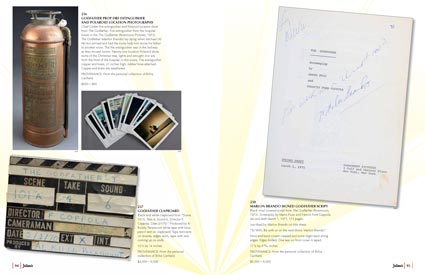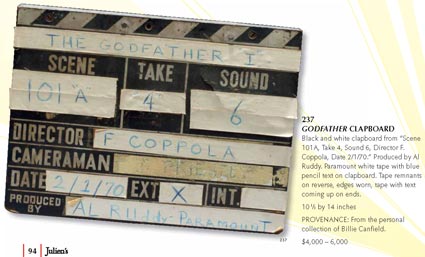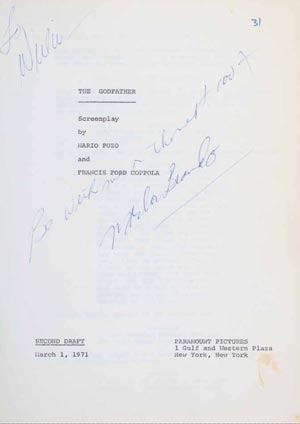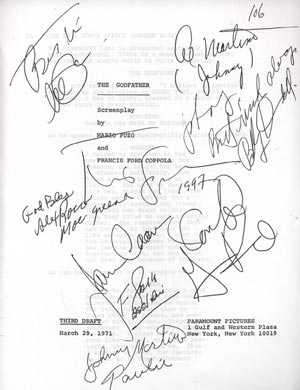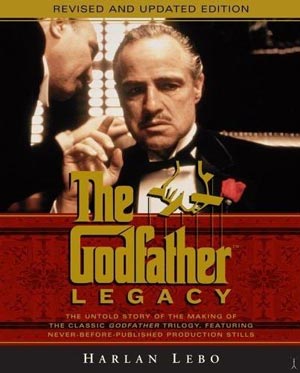As reported in past articles, Julien’s held their “Entertainment Sale Hollywood Memorabilia” auction at Planet Hollywood in Las Vegas on June 21 (LINK). One of the items featured prominently in their marketing raised some questions on the Movie Prop Forum, with Rick Spector of Stairway to the Stars questioning the date on the clapboard (or clapperboard) attributed to use in The Godfather, as well as the “I” in the film title. I’ve since picked up a copy of The Godfather Legacy by Harlan Lebo which seems to raise further questions about the markings on this piece that realized $4,500.00 at auction (plus 25%-27.5% Buyer’s Premium).
Below are the pages from the Julien’s auction catalog showcasing the three Godfather lots that were offered in the event:
Note that the Second Draft of the screenplay is dated March 1, 1971.
Below is a close-up of the Godfather clapboard:
All three items note provenance as from “the personal collection of Billie Canfield”. Per IMdb, Mr. Canfield was an uncredited set dresser on The Godfather (LINK).
The information on the clapboard is as follows:
Film: THE GODFATHER “I”
SCENE: 101 “A”
TAKE: “4”
SOUND: 6
DIRECTOR: F COPPOLA
CAMERAMAN:
DATE: 2/1/70
EXT: X
INT:
PRODUCED BY: AL RUddy PARAMOUNT
Without doing any research, comparing the Second Draft script date of 03/01/71 with the 02/01/70 date on the clapboard raises questions, as the clapboard is dated more than one year prior to the unfinished screenplay:
As a benchmark, I found a Third Draft of the screenplay at GodfatherTrilogy.com, dated 03/29/71 – just 28 days after the Second Draft date:
That March 29, 1971 draft date is also referenced numerous times in the latest release of The Godfather Legacy by Harlan Lebo. The bibliography of this work cites the shooting script as dated March 29,1971.
“2/1/70”
The following excerpts contrast the “2/1/70” date on the clapboard…
The Godfather Legacy, Page 8:
Indeed, financial and creative restrictions did hamper the search for a producer. Through the fall of 1969 and winter of 1970 as the hunt for a production team for The Godfather began, the only response Bart and Evans heard was “no.”
The Godfather Legacy, Page 11:
On March 23, 1970, Paramount announced that Ruddy would produce The Godfather through his company, Alfran Productions.
O
On April 14 [1970], the studio announced that Puzo had been hired to write the first draft of the screenplay for The Godfather for $100,000 and a percentage of the net profits – more than the studio had paid for the original rights to the material.
O
By the spring of 1970, Puzo began his work on a project that the studio only grudgingly wanted, written by an author who had never created a screenplay, and coordinated by a producer who had never brought a successful picture to the screen. The studio would soon discover yet another problem: no one wanted to direct it.
In the fall of 1970, the early stages of preproduction proceeded for The Godfather. Puzo had been working on the script for six months, alternating time at the typewriter with trips home to Long Island.
Creating an acceptable script was, of course, critical to moving forward with production. But the key issue remained: Who would direct the film?
The Godfather Legacy, Page 51:
In early September 1970, Ruddy had predicted that filming of The Godfather would begin in the middle of November, even though at the time he had not yet hired a direction, a production team, or any of the actors.
The Godfather Legacy, Page 25:
On September 27, 1970, Paramount publicly confirmed the rumors that had for days been floating around Hollywood: Coppola was signed to direct The Godfather.
O
To kick off the production, on September 29 Evans held a press conference at Paramount’s Beverly Hills offices to introduce Ruddy, Puzo, and Coppola to the entertainment media.
The Godfather Legacy, Page 26:
The filming was scheduled to begin on January 2, 1971 – a delay from the previously promised start time of November.
The Godfather Legacy, Page 74:
By now, the production had a start date that would stick: March 29 [1971].
The Godfather Legacy, Page 200:
By December 1971, The Godfather was almost completed, and late in the year and early in 1972, the film was screened for Paramount staff and exhibitors.
The film was released in theaters March 24, 1972.
THE GODFATHER “I”
The following excerpts raise questions about the the “I” designation in the title on the clapboard (i.e. “The Godfather Part I“)…
The Godfather Legacy, Page 184:
The night of July 2 [1971], The Godfather production crew would film the last shot of principal photography in New York…
O
Coppola requested and received a two-week break before taking his crew to Italy for the Sicilian shoot.
The Godfather Legacy, Page 185:
Coppola went to Italy, but only with a skeleton crew.
The Godfather Legacy, Page 189:
The two-week break in filming, plus the relatively peaceful shoot in Sicily had a calming influence on the production. By August 1971, when postproduction began, the enthusiasm was palpable.
The Godfather Legacy, Page 214:
The Godfather was still months from release when Paramount began to plan a sequel. By the time Coppola returned from Sicily in August [1971], the studio had given the green light to start a script for a second Godfather film. At one time or another, the proposed sequel was known by a host of names: Michael Corleone, Don Michael, The Son of Don Corleone, and eventually The Godfather Part II. In August 1971, Paramount signed Mario Puzo to write the script.
Puzo was the lone member of the production team who was secured for the sequel. Coppola was still busy with The Godfather, mired in postproduction and the premiere still months away. A sequel was far from his mind.
CAMERAMAN
Interestingly, though the “CAMERAMAN” tape is clearly missing or of a different type/age/condition, it should read Gordon Willis, cinematographer for The Godfather (see IMdb).
Instead the space for “CAMERAMAN” is aged/worn tape inconsistent with the brighter tape over the rest of the board. However, there is enough ink and surface area left to make out the name – it appears to read “T PRIESTL”:
There is a Tom Priestley Jr. with applicable “Camera” and “Cinematographer” credits predating and following The Godfather (see IMdb).
Though Mr. Canfield only shows six credits on IMdb (two uncredited, all 1972-1982) both William Canfield and Tom Priestley Jr. share credits on the film Saturday Night Fever (see IMdb):
- William Canfield: Saturday Night Fever (1977) [set dresser] (uncredited)
- Tom Priestley Jr: Saturday Night Fever (1977) (camera operator)
Mr. Priestley Jr. shows no credits on The Godfather.
Conclusion
Both the date (2/1/70) and the title (The Godfather “I”) seem inconsistent with facts presented in the book, in terms of dates and the timing of the first acknowledgment of planning for a sequel to The Godfather.
It is also an unusual coincidence that the cinematographer on the clapperboard does not read Gordon Willis but appears to show “T PRIESTL”, with Tom Priestley Jr. being the credited as Camera Operator on a film that Mr. Canfield shows credits on as a set decorator.
Jason De Bord


